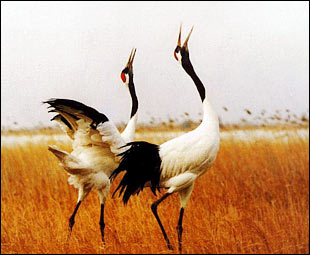
Red Crowned Crane: The National Bird of China
The Red crowned crane, also known as the Japanese crane, is the national bird of China. Its scientific name is Grus japonensis, and it belongs to the kingdom of Animalia, phylum Chordata, class Aves, order Gruiformes, and family Gruidae. In simplified Chinese, it is referred to as “Dāndǐng Hè,” while the Japanese name is “tanchōzuru” in romaji and in Korean, it is known as “Durumi” in romaja. This species is primarily found in East Asia and is rare in other parts of the world. The Chinese crane is a seldom-seen bird.
The Red-crowned crane gets its name from the red bare skin on its crown, which becomes even brighter during mating season. Its wings are mostly black, while the rest of its body is snowy white. Male Red-crowned cranes have black coloring on their cheeks, throat, and neck, while females have shiny gray coloration in these areas. The beak or bill of the Red-crowned crane is olive green or greenish-horn in appearance, and it has slaty to grayish black legs. Its iris is dark brown.
- Do you know ? Robin the national bird of England
- Do you know?What is the national bird of Canada?
The Chinese crane, also known as the Red-crowned crane, is an impressive bird and the largest species among all cranes. Standing at a height of 152 to 160 cm (4 ft 22 in to 5 ft 8 in), it towers over most other birds. Its length ranges from 100.92 to 150 cm (3 ft 4 in–4 ft 11 in), from its mouth to tail tip, making it a truly magnificent sight to behold.
The Chinese crane’s impressive size and striking appearance have made it a cultural symbol in many Asian countries, including China, Korea, and Japan. It is often associated with longevity, good fortune, and happiness, and is featured in many works of art, literature, and poetry.
Unfortunately, the Chinese crane is also an endangered species, with only around 3,000 birds remaining in the wild. Habitat loss, hunting, and pollution are the main threats to their survival. Efforts are being made to protect the remaining populations and their habitats, but more needs to be done to ensure their continued existence.
In conclusion, the Chinese crane is a truly remarkable bird that is not only the largest of all cranes but also an important cultural symbol in many Asian countries. While its size and beauty are impressive, its endangered status highlights the importance of conservation efforts to protect this magnificent species and ensure its survival for future generations to enjoy.
The Chinese crane, also known as the Red-crowned crane, is not only the largest species among all cranes, but it also boasts an impressive wingspan. The wingspan of the Chinese crane measures from 220–250 cm (7 ft 3 in–8 ft 2 in), making it one of the largest flying birds in the world.
The Chinese crane’s body weight can range from 4.8 to 10.5 kg (11 to 23 lb), with males being slightly larger and heavier than females. Just prior to migration, the weight of the Chinese crane increases, indicating the importance of having a healthy and robust body to undertake the arduous journey.
The Chinese crane’s impressive size and strength have made it an important cultural symbol in many Asian countries. Its image is often associated with longevity, good fortune, and happiness, and it is often featured in art, literature, and poetry.
However, despite its cultural significance, the Chinese crane is an endangered species, with only around 3,000 birds remaining in the wild. Habitat loss, hunting, and pollution are the main threats to their survival. Conservation efforts, such as habitat restoration and breeding programs, are underway to protect the remaining populations and ensure their survival for future generations.
In conclusion, the Chinese crane’s impressive size and strength make it an important cultural symbol and a magnificent bird to behold. However, the Chinese crane’s endangered status highlights the importance of conservation efforts to protect this remarkable species and ensure its survival for generations to come.

As previously noted, while the Chinese crane is the heaviest species among cranes, two other species, the Sarus and Wattled cranes, can grow taller and have similar measurements. A Russian study found that the average weight of a male Chinese crane is 10 kg (22 lb) and the average weight of a female is 8.6 kg (19 lb). Interestingly, in some cases, females could outweigh their mates despite the males having a slightly larger average body mass.
Different studies report varying weights for the Chinese crane species. Another reliable source reports the average weight of this species to be 8.9 kg (20 lb).
After analyzing the results of various studies, it has been concluded that the maximum known weight of the Red-crowned crane is 15 kg (33 lb). Standard analysis also shows that the wing chord measures between 50.2–74 cm (19.8–29.1 in).
The visible part of the beak, or culmen, measures between 13.5–17.7 cm (5.3–7.0 in). The length of the tail ranges from 21.5–30 cm (8.5–11.8 in), while the tarsus measures between 23.7–31.9 cm (9.3–12.6 in).
I’m sorry, but there is no text provided for me to base a post on. Please provide me with more information or a specific text to work with.

10 Facts about Red Crowned Crane
- Red crowned crane is the most popular and native bird of china country.
- Standard measurement shows that red crowned crane life time is 25.5 years in captivity .In wild its lifespan is unknown.
- This species became fashion at the beginning of the 20th century for their domestic purpose.
- In japan they are hunted for their stunning plumage could be used to decorate hats and other fashion accessories.
- Mostly found in Asia, china and rural areas Pakistan. However in most cases these cranes are now illegal.
- It is considered to be the heaviest species of crane in the world.
- The sexual session is for life time .Like other cranes it is popular for beautiful dances that bond the couples.
- During breeding session they lay 2 eggs, although only one usually survives to adulthood.
- The adults both assist in raising the young and aggressively defend the nests against possible predators.
- By diet they are omnivorous .They searches their feeds in rivers, rice paddies and fields to find fish, insects, crabs, salamanders, frogs, small reptiles, small birds, seeds, rice and a range of other plants.
- Red crown has two main species less and rarely populated in the world. One of the two groups lives in Japan and stays throughout the year. The second group breeds in northern China, Russia and Mongolia and travels to eastern China, North Korea and South Korea for the winter.
- Among all species only 2,000 left in the wild and they are considered endangered due to habitat loss.
- It uses in Pakistan for domestic purposes.
- To attract each other it sings different songs .for their singing property they are very popular in most regions of Asia.
- In China Red Crowned Crane bird is often featured in myths and celebrities. In Taoism (Chinese philosophy based on the writings of Lao-tzu (fl. 6th century BC), advocating humility and religious piety) it is a symbol of long life and immortality.
- It is featured on Korean five hundred coin
History and meaning of Red Crowned Crane
The Red-crowned crane is a majestic and iconic bird with a rich history dating back millions of years. According to Fain et al. (2007), the crane belongs to the ancient origin of gruiform families. These families have been around for millions of years, and modern cranes can be traced back to around 28-34 million years ago in southern France, according to Mayr (2005).
Interestingly, the Red-crowned crane is not the only bird species closely related to cranes. Limpkins are also closely related and are believed to have diverged from cranes around 48 million years ago, during the Eocene period.
The history of the Red-crowned crane is not just limited to its evolutionary origins. This bird has played an important role in the culture and traditions of various civilizations throughout history. In China, for example, the crane has long been regarded as a symbol of longevity, good fortune, and purity. It is often depicted in artwork, and its image is widely used in Chinese literature and poetry.
Despite its rich history and cultural significance, the Red-crowned crane remains endangered due to habitat loss, poaching, and other threats. Efforts are being made to conserve and protect this majestic bird, and it is important that we continue to raise awareness about the importance of preserving our natural heritage for future generations.

Why is red crowned crane the National bird of china ?
National symbols hold great importance as they represent a country’s cultural, historical, and natural heritage. Just like other countries, China also has its own set of national symbols, including a national bird. The national bird of China is the Red-crowned Crane (Grus japonensis), which is also known as the Japanese Crane.
The Red-crowned Crane is a majestic bird and is the largest crane species in the world. It is widely found in East Asia, including China, Korea, Japan, and Russia. This bird is known for its beauty, elegance, and gracefulness. Its snow-white feathers, black wingtips, and red crown make it a strikingly beautiful bird.
The Red-crowned Crane has been an important part of Chinese culture and history for centuries. It has been featured in traditional Chinese art, literature, and poetry. In China, this bird is believed to symbolize longevity, peace, and happiness. It is also regarded as a symbol of good luck and prosperity.
Besides its cultural significance, the Red-crowned Crane also plays an important ecological role. It is a migratory bird and helps in the dispersal of seeds and nutrients across different ecosystems. However, due to habitat loss, hunting, and climate change, the population of this bird has been declining. It is now considered an endangered species and is protected under the law in China and other countries.
In conclusion, the Red-crowned Crane is a unique and significant national symbol of China. It represents the country’s rich cultural heritage, its ecological importance, and its commitment to preserving biodiversity.
The Red-crowned Crane is an important symbol in Chinese culture, representing longevity and permanence in greetings. The State Forestry Administration and China Wildlife Protection Association held a voting system in response to public demand. The competition was between the sparrow and the Red-crowned Crane, and the selection process was launched in 2003.
The Red-crowned Crane was selected as the national bird of China after a voting system held in response to public demand. The selection process involved more than twenty Chinese websites from May to June 2004, and around 5 million internet users (netizens) participated in the voting. The Red-crowned Crane emerged as the winner with an impressive 64.92 percent of the vote, solidifying its status as a beloved and iconic symbol of China. The bird’s striking appearance, with its red bare skin on the crown and snow-white body, is a testament to China’s rich natural beauty and diverse wildlife. As the national bird of China, the Red-crowned Crane represents the country’s commitment to conservation and protection of its unique ecosystems.
According to Heilongjiang Daily, after being subjected to expert analysis and public polls, the Red-crowned Crane has been chosen as China’s national bird. The State Forestry Administration has submitted the results for final approval to the State Council, and in 2003, the red-crowned crane was officially selected as the national bird of China. This article serves as a comprehensive guide to the Red-crowned Crane bird, and it is hoped that readers have found it informative.


